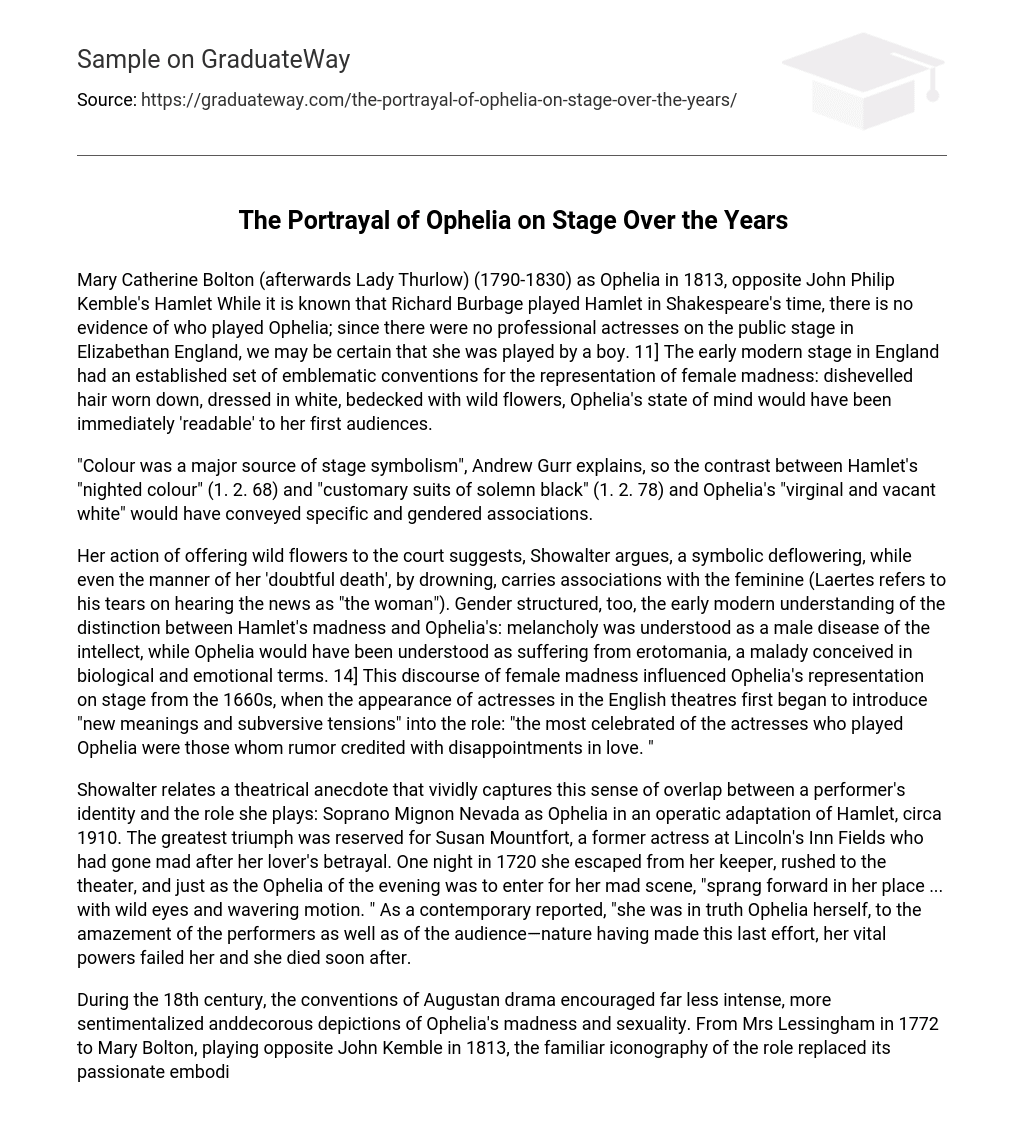Mary Catherine Bolton (afterwards Lady Thurlow) (1790-1830) as Ophelia in 1813, opposite John Philip Kemble’s Hamlet While it is known that Richard Burbage played Hamlet in Shakespeare’s time, there is no evidence of who played Ophelia; since there were no professional actresses on the public stage in Elizabethan England, we may be certain that she was played by a boy. 11] The early modern stage in England had an established set of emblematic conventions for the representation of female madness: dishevelled hair worn down, dressed in white, bedecked with wild flowers, Ophelia’s state of mind would have been immediately ‘readable’ to her first audiences.
“Colour was a major source of stage symbolism”, Andrew Gurr explains, so the contrast between Hamlet’s “nighted colour” (1. 2. 68) and “customary suits of solemn black” (1. 2. 78) and Ophelia’s “virginal and vacant white” would have conveyed specific and gendered associations.
Her action of offering wild flowers to the court suggests, Showalter argues, a symbolic deflowering, while even the manner of her ‘doubtful death’, by drowning, carries associations with the feminine (Laertes refers to his tears on hearing the news as “the woman”). Gender structured, too, the early modern understanding of the distinction between Hamlet’s madness and Ophelia’s: melancholy was understood as a male disease of the intellect, while Ophelia would have been understood as suffering from erotomania, a malady conceived in biological and emotional terms. 14] This discourse of female madness influenced Ophelia’s representation on stage from the 1660s, when the appearance of actresses in the English theatres first began to introduce “new meanings and subversive tensions” into the role: “the most celebrated of the actresses who played Ophelia were those whom rumor credited with disappointments in love. “
Showalter relates a theatrical anecdote that vividly captures this sense of overlap between a performer’s identity and the role she plays: Soprano Mignon Nevada as Ophelia in an operatic adaptation of Hamlet, circa 1910. The greatest triumph was reserved for Susan Mountfort, a former actress at Lincoln’s Inn Fields who had gone mad after her lover’s betrayal. One night in 1720 she escaped from her keeper, rushed to the theater, and just as the Ophelia of the evening was to enter for her mad scene, “sprang forward in her place … with wild eyes and wavering motion. ” As a contemporary reported, “she was in truth Ophelia herself, to the amazement of the performers as well as of the audience—nature having made this last effort, her vital powers failed her and she died soon after.
During the 18th century, the conventions of Augustan drama encouraged far less intense, more sentimentalized anddecorous depictions of Ophelia’s madness and sexuality. From Mrs Lessingham in 1772 to Mary Bolton, playing opposite John Kemble in 1813, the familiar iconography of the role replaced its passionate embodiment. Sarah Siddons played Ophelia’s madness with “stately and classical dignity” in 1785. [17] Since that time, Ophelia has been a frequent subject in artwork, often in a Romantic or Classical style, as the images on this page show.
Many great actresses have played Ophelia on stage over the years. In the 19th century she was portrayed by Helen Faucit, Dora Jordan, Frances Abington, and Peg Woffington, who won her first real fame by playing the role. [18] Theatre manager Tate Wilkinson declared that next to Susannah Maria Cibber, Elizabeth Satchell (of the famous Kemble family) was the best Ophelia he ever saw. [19] Ophelia has been portrayed on screen since the days of early silent films. Dorothy Foster played Ophelia opposite Charles Raymond’s Hamlet in the 1912 film Hamlet.
Jean Simmons played Ophelia opposite Laurence Olivier’s Oscar-winning Hamlet performance in 1948; Simmons was also nominated for the Academy Award for Best Supporting Actress. More recently, Ophelia has been portrayed by Helena Bonham Carter (1990), Kate Winslet (1996), Julia Stiles (2000) and Gugu Mbatha-Raw (2009). Themes associated with Ophelia have led to movies such as Ophelia Learns to Swim(2000), and Dying Like Ophelia (2002). [20] In many theatre and film adaptations she is portrayed barefoot in the mad scenes, including Kozintsev’s 1964 version, Zeffirelli’s 1990 film, 1996 and2000 versions.
Psychologist Mary Pipher attributed the name of her 1994 book Reviving Ophelia to Shakespeare’s Ophelia. In her book, Pipher examines the troubled lives of the modern American adolescent girls. Through her extensive clinical work with troubled young women, Pipher takes a closer look at the competing influences that lead adolescent girls in a negative direction. For example, Pipher attributes the competing pressure from parents, peers, and the media for girls to reach an unachievable ideal. Girls are expected to meet goals while still holding on to their sanity.
These pressures are further complicated when young women undergo physical changes out of their control, like the biological developmental changes in puberty. Shakespeare’s Ophelia was thought to be going through erotomania; however, Ophelia and Pipher’s patients display many of the same characteristics. Pipher believes the Ophelia of Shakespeare’s era was entirely misunderstood, much like her patients. In order to understand the complex mind of an adolescent, one must look at the woman from a holistic perspective in order to gain a greater understanding of her outlook on life.
Lisa Klein’s 2006 novel, Ophelia, uses her as the main protagonist. As opposed to her portrayal in the play, Ophelia uses madness as a cover, much like Hamlet does. Hamlet secretly marries her, though she is unaware of his own ruse of insanity. She eventually fakes her own death to escape the Danish court and preserve her life and that of her unborn baby, leaving to a convent in France. While there, she studies herbal remedies and takes on a task of being a medical worker for the sisters.





